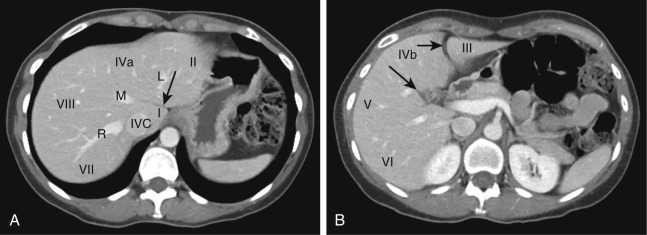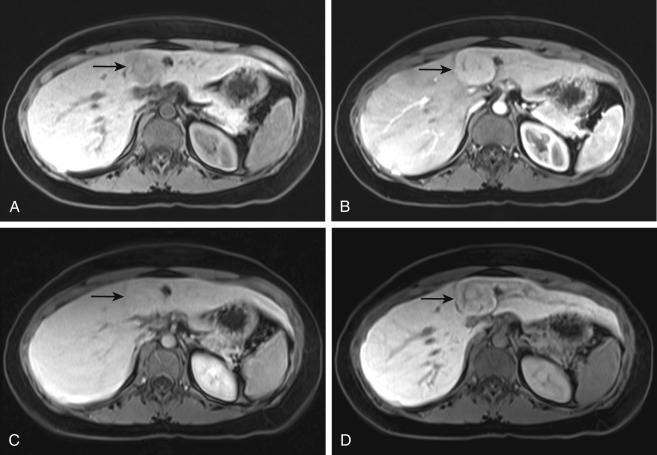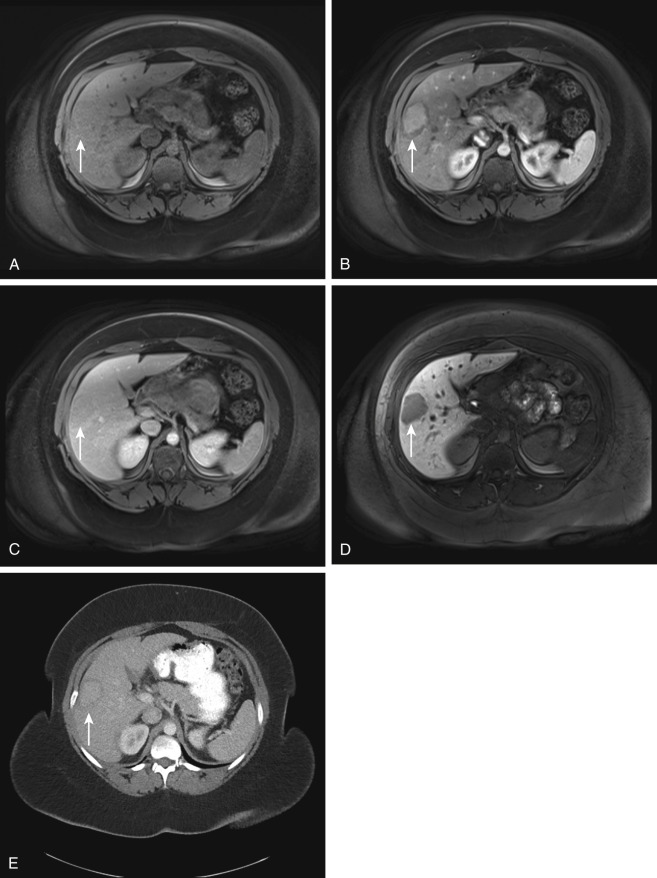Physical Address
304 North Cardinal St.
Dorchester Center, MA 02124
The most common clinical indications include:
Characterization of indeterminate hepatic lesions detected on prior cross-sectional imaging.
Surveillance of cirrhotic patients for hepatocellular carcinoma (HCC).
Surveillance of patients with primary sclerosing cholangitis (PSC) for cholangiocarcinoma.
Staging and response assessment of patients with hepatobiliary malignancies.
Pretreatment and post-treatment evaluation of patients undergoing liver transplantation.
Evaluation of patients with abdominal symptoms or signs (e.g., right upper quadrant pain, abnormal liver function tests) that may be secondary to hepatobiliary disease.
Assessment for traumatic injury to liver, biliary tree, or gallbladder (mainly using CT).
Assessment for presence, location, and causes of biliary obstruction (mainly using MRI).
Diagnosis and response assessment in patients with primary (genetic) hemochromatosis (using MRI).
Providing guidance for percutaneous biopsy or intervention for hepatobiliary disease.
Multiplanar heavily T2-weighted images (echo time [TE] 90 to 180 msec).
Axial in-phase and out-of-phase T1-weighted gradient recalled echo (GRE) images.
Axial fat-suppressed T2-weighted images.
Axial diffusion-weighted images (DWI) with apparent diffusion coefficient (ADC) parametric map images.
Coronal (and sometimes axial) very heavily T2-weighted magnetic resonance cholangiopancreatography (MRCP) images (TE >500 msec).
Axial pre- and postcontrast fat-suppressed T1-weighted images.
MRCP is a noninvasive fluid-sensitive heavily T2-weighted sequence, which is primarily used to assess the biliary and pancreatic ductal systems. Fluid-containing structures (bile ducts, pancreatic duct, bowel, etc.) appear very high in signal intensity relative to a dark tissue background. MRCP can be displayed with a thin-section technique (2- to 5-mm thick slices) or a thick slab technique (projection images 20 to 60 mm in thickness shown in coronal and oblique coronal planes). Thick slab MRCP images are useful to quickly assess for the presence of biliary and pancreatic ductal dilation, whereas thin-section MRCP images are useful to assess for the presence and location of transition sites of ductal obstruction along with detection of abnormal internal contents within the ductal systems such as may be caused by calculi, debris, or tumors.
Hepatobiliary MRI contrast agents are in part taken up by functioning hepatocytes and excreted into the biliary system. Gadoxetate disodium (Eovist, Bayer HealthCare Pharmaceuticals Inc.) and gadobenate dimeglumine (Multihance, Bracco Diagnostics Inc.) are the two commonly used hepatobiliary MRI contrast agents used in clinical practice. Eovist has approximately 50% biliary excretion, while Multihance has 2% to 5% biliary excretion.
The most common indications for use of hepatobiliary MRI contrast agents in clinical practice are to differentiate focal nodular hyperplasia (FNH) from hepatic adenoma, to characterize indeterminate hepatic lesions in patients with cirrhosis, and to assess for presence of bile leak.
The liver is the largest organ in the abdomen and has attenuation of 50 to 70 Hounsfield units (HU) on CT, which on average is about 10 HU greater than that of the spleen. On MRI, the liver has high T1-weighted signal intensity relative to spleen secondary to abundant intracellular protein and paramagnetic substances ( Figure 28-1, A ), whereas the liver has low T2-weighted signal intensity relative to spleen ( Figure 28-1, B ). The normal contour of the liver is smooth, and the liver parenchyma normally homogeneously enhances.

Following the intravenous administration of contrast material, sequential phases of enhancement of the liver are seen as follows:
The early arterial (or hepatic arterial) phase of enhancement occurs ≈10 to 20 seconds after contrast administration, when arteries will enhance but portal and hepatic veins do not enhance. This phase is useful for delineation of arterial anatomy prior to therapeutic intervention.
The late arterial (or portal inflow) phase of enhancement occurs ≈25 to 35 seconds after contrast administration, when arteries enhance and portal veins begin to enhance, but hepatic veins do not enhance. In this phase, the spleen has heterogeneous enhancement, the kidneys are usually in the corticomedullary phase of enhancement, and hypervascular lesions are seen to best effect ( Figure 28-1, C ).
The hepatic venous (or portal venous or parenchymal) phase of enhancement occurs ≈50 to 90 seconds after contrast administration, when hepatic veins enhance. In this phase, the spleen has homogeneous enhancement, the kidneys may be in the corticomedullary or nephrographic phase of enhancement, the liver parenchyma homogeneously enhances, hypovascular lesions are seen to best effect, and hypervascular lesions may have washout of enhancement relative to liver parenchyma ( Figure 28-1, D ).
The delayed (or excretory or equilibrium) phase of enhancement occurs ≈>120 to 180 seconds after contrast administration, when liver parenchyma and vessels decrease in enhancement, while the renal collecting systems increasingly opacify with excreted intravenous contrast material. This phase is useful to more definitely characterize certain hepatic lesions, including hemangioma (which has persistent delayed phase enhancement), FNH (which has delayed phase central scar enhancement), and cholangiocarcinoma (which often has delayed phase enhancement of fibrous stroma).
The hepatobiliary phase of enhancement is subsequently visualized on MRI if a hepatobiliary MRI contrast agent was intravenously administered, using T1-weighted MR images typically acquired >20 minutes after contrast administration. In this phase, the liver parenchyma homogeneously retains contrast material and appears hyperintense relative to skeletal muscle, the hepatic vessels appear hypointense relative to liver parenchyma, and the biliary tree, gallbladder, and renal collecting systems (given the ≈1 : 1 ratio of hepatobiliary : renal excretion of gadoxetate disodium) become opacified with excreted intravenous contrast material ( Figure 28-1, E ).
The liver is subdivided into right, left, and caudate lobes. The right hepatic lobe is further subdivided into anterior and posterior segments, and the left hepatic lobe is further subdivided into medial and lateral segments. Whereas the hepatic veins are located between segments of the liver (i.e., are intersegmental in location), the portal veins, hepatic arteries, and bile ducts are located within segments of the liver (i.e., are intrasegmental in location). Superiorly, the middle hepatic vein delineates the boundary between the left and right hepatic lobes, the right hepatic vein delineates the boundary between the anterior and posterior segments, and the left hepatic vein delineates the boundary between the medial and lateral segments. Inferiorly, the interlobar fissure, which is in the plane of the gallbladder fossa, delineates the boundary between the left and right hepatic lobes, and the fissure for the falciform ligament (or left intersegmental fissure) delineates the boundary between the medial and lateral segments.
The Bismuth-Couinaud system is often used to provide a segmental nomenclature for localizing focal hepatic lesions. In this system, vertically oriented planes along the right, middle, and left hepatic veins are maintained and further divided by a horizontal plane through the right and left portal veins to divide the liver into 9 “segments” comprised of the caudate lobe and 8 hepatic subsegments.
Segment I is the caudate lobe of the liver, which is located posterior to the fissure for the ligamentum venosum, and which is functionally an autonomous part of the liver. It has a separate blood supply, venous drainage, and biliary drainage. Segments II, IVa, VIII, and VII are the lateral, medial, anterior, and posterior segments of the liver, respectively, located above the plane of the portal vein. Segments III, IVb, V, and VI are the lateral, medial, anterior, and posterior segments of the liver, respectively, located below the plane of the portal vein ( Figure 28-2 ).

The intrahepatic bile ducts are normally ≤ 2 mm in caliber, and they coalesce to form segmental bile ducts. The segmental bile ducts then join to form the right and left hepatic ducts, which subsequently coalesce to form the extrahepatic bile duct.
The extrahepatic bile duct extends from the liver to the second portion of the duodenum within the hepatoduodenal ligament, anterior to the main portal vein and lateral to the hepatic artery. It is comprised of the more superiorly located common hepatic duct (CHD), which is normally ≤ 6 mm in caliber, and the more inferiorly located common bile duct (CBD), which is normally ≤ 8 mm in caliber (see Figure 28-1, B ). The cystic duct, which communicates with the gallbladder, joins to the CHD to form the CBD. The CBD then joins inferiorly with the main pancreatic duct to form the ampulla of Vater, which then drains into the second portion of the duodenum via the major duodenal papilla.
Bile duct walls are normally thin and smooth, and no filling defects are normally seen in the biliary tree or gallbladder.
The gallbladder is ≈10 cm long and 3 to 5 cm in diameter and is located inferiorly to the liver along the interlobar fissure in the gallbladder fossa. The normal gallbladder wall thickness is ≤ 3 mm, and the surrounding visceral fat is normally homogeneous and similar in attenuation and signal intensity to fat elsewhere in the body (see Figure 28-1, B ).
Determination of the origin of a focal hepatic lesion as hepatocellular or extrahepatocellular is useful to establish a definitive diagnosis for the lesion. Commonly encountered lesions of hepatocellular origin include FNH, hepatic adenoma, focal hepatic steatosis, regenerative nodule, and HCC.
In general, lesions that are isointense to hyperintense in signal intensity relative to liver parenchyma on in-phase T1-weighted images are hepatocellular in origin, whereas lesions that are low in signal intensity relative to liver parenchyma are generally extrahepatocellular in origin. Presence of intralesional lipid content, as manifested by a loss of signal intensity within a hepatocellular origin hepatic lesion on out-of-phase T1-weighted images relative to in-phase T1-weighted images, is often seen in all of the hepatocellular origin hepatic lesions listed above except for FNH but is not seen in most extrahepatocellular origin hepatic lesions with the exception of lipid-containing hepatic metastases from clear cell renal cell carcinoma or adrenocortical carcinoma. Retention of hepatobiliary MRI contrast material within a lesion during the hepatobiliary phase of enhancement generally indicates presence of either focal hepatic steatosis, regenerative nodule, or FNH, whereas all other hepatic lesions appear hypointense relative to surrounding liver parenchyma during this phase of enhancement. Lesions with high T2-weighted signal intensity relative to liver but intermediate signal intensity relative to spleen tend to be due to a malignant neoplasm, whereas lesions with high T2-weighted signal intensity relative to both liver and spleen parenchyma are most often due to cysts or hemangiomas.
See Tables 28-1 and 28-2 below for summaries of the MRI features of hepatic lesions of hepatocellular and extrahepatocellular origin.
| LESION | T1-W | T2-W | HEAVILY T2-W | POSTCONTRAST T1-W | OTHER |
|---|---|---|---|---|---|
| Focal steatosis | = | = to ↑ | = | = on all phases | Often geographic in shape and in particular distribution, no mass effect upon vessels |
| FNH | =; ↓ of central scar |
=; ↑ of central scar |
= | ↑↑↑ on A phase; = on V, D, and HB phases; ↑ of central scar on D phase |
Homogeneous enhancement, central scar, no lipid content |
| Hepatic adenoma | = to ↑; ↑↑ if hemorrhagic |
= to ↑ | = | ↑↑ on A phase; = to ↓ on V and D phases; ↓ on HB phase |
More heterogeneous, a/w oral contraceptive use |
| Regenerative nodule | = to ↑; ↓ if siderotic |
= to ↓ | = | = on all phases | Small, multiple, in cirrhotic liver |
| HCC | = to ↓ | = to ↑ | = | ↑↑ on A phase; = to ↓ on V and D phases; ↓ on HB phase |
More heterogeneous, often in cirrhotic liver, ± vascular invasion, ± metastatic disease |
| LESION | T1-W | T2-W | HEAVILY T2-W | POSTCONTRAST T1-W | OTHER |
|---|---|---|---|---|---|
| Cyst | ↓↓↓; ↓↓ to ↑↑ if proteinaceous or hemorrhagic |
↑↑↑; ↓↓ to ↑↑ if proteinaceous or hemorrhagic |
↑↑↑; ↓↓ to ↑↑ if proteinaceous or hemorrhagic |
No or minimal thin rim enhancement | |
| Hemangioma | ↓ | ↑↑↑ | ↑↑ | Peripheral nodular discontinuous enhancement on A phase; centripetal fill-in on V phase; persistent enhancement on D phase | Sometimes flash-filling in A phase when small in size; often central cleftlike area of cystic degeneration or liquefaction when large in size |
| Hepatic metastasis | ↓ | ↑ | = to ↑ | Variable, may have continuous rim enhancement, ± “peripheral washout” sign in V or D phase | History of primary tumor often known, often heterogeneous, usually multiple, ± extrahepatic metastatic disease, no cirrhosis present |
| Abscess | ↓↓; ↓↓↓ if contains foci of gas |
↑↑; ↓↓↓ if contains foci of gas |
↑; ↓↓↓ if contains foci of gas |
Rim and septal enhancement in A or V phase that persists in D phase, regional hyperenhancement | Often clustered, may be surrounded by edema |
| Intrahepatic cholangiocarcinoma | ↓ | ↑ | = to ↑ | Heterogeneous peripheral enhancement in A and V phases with gradual centripetal fill-in on D phase | Heterogeneous, ± biliary obstruction, ± capsular retraction, ± extrahepatic metastatic disease |
| Hepatic lymphoma | ↓ | ↑ | = to ↑ | Hypoenhancing on all phases | Homogeneous, usually multiple, often associated with lymphadenopathy |
CT and MRI play an important role in preoperative evaluation of liver transplant donors, as well as in pre- and postoperative evaluation of recipients of liver transplants.
In potential liver donors, preoperative evaluation can be performed with three-phase dynamic contrast-enhanced CT or MRI (depending on particular institution) to delineate the hepatic arterial, portal venous, hepatic venous, and biliary anatomy (because anatomic variations are common) and to measure hepatic lobar volumes. This imaging evaluation is also performed to identify any incidental lesions in the abdomen of the donors, which may or may not need attention prior to surgery.
In potential liver transplant recipients, preoperative evaluation is helpful to delineate the underlying hepatobiliary and vascular anatomy, to evaluate for preexisting hepatobiliary disease, and to stage underlying hepatic malignancy.
Post-transplant evaluation in liver transplant recipients is primarily focused on vascular or biliary complications. Although ultrasonography (US) is often the initial imaging modality to evaluate these patients, CT and MRI are often used for problem-solving. Commonly encountered vascular complications following liver transplantation include thrombosis or stenosis of arteries or veins and arterial pseudo-aneurysm formation. Commonly encountered biliary complications following liver transplantation include biliary stenosis (most commonly at the anastomosis), bile duct strictures, biliary leak, biloma formation, choledocholithiasis, and bile duct necrosis. Other important complications include abdominal abscess, hematoma, recurrence of preexisting malignancy, recurrence of cirrhosis, transplant rejection, and post-transplant lymphoproliferative disorder (PTLD).
FNH is the most commonly encountered benign hepatic lesion of hepatocellular origin, and is more frequently seen in women. FNH, usually identified as an incidental lesion on CT and MRI, is a focal regenerative response of hepatocytes to an underlying hepatic vascular malformation, which also contains Kupffer cells.
On MRI, FNH is typically isointense on T1-weighted images and T2-weighted images relative to liver parenchyma. On dynamic contrast-enhanced images, FNH shows intense homogeneous arterial phase enhancement, which becomes isointense to liver parenchyma on venous and delayed phase images. A central scar is often present, which has low T1-weighted and high T2-weighted signal intensity relative to liver parenchyma and does not enhance on arterial phase images, although delayed phase enhancement is typically seen. On hepatobiliary phase T1-weighted images, FNH retains hepatobiliary contrast material such that portions of the lesion will appear isointense or hyperintense to liver parenchyma ( Figure 28-3 ).

FNH is usually not identifiable on unenhanced CT images, and it has no associated calcifications. The enhancement pattern of FNH on CT is similar to that on MRI.
Hepatic adenoma is the second most common benign lesion of hepatocellular origin, and it is most commonly encountered in young women, especially in those who are taking oral contraceptives. It may also be associated with anabolic corticosteroid use as well as type I glycogen storage (von Gierke's) disease. Hepatic adenoma, although a benign neoplasm, is often treated with surgical resection given the risk of hemorrhage, especially for lesions that are ≥ 3 to 4 cm and/or located in the subcapsular region of the liver. Hepatic adenomatosis is a specific rarer condition, which is defined by presence of more than 10 hepatic adenomas in the liver and which is associated with a small but increased risk of malignant transformation into HCC.
On MRI, hepatic adenoma is isointense to hyperintense relative to liver parenchyma on T1-weighted images ( Figure 28-4, A ), often contains intralesional lipid (seen by loss of signal intensity on out-of-phase T1-weighted images relative to in-phase T1-weighted images), and is isointense to slightly hyperintense relative to liver parenchyma on T2-weighted images. When subacute hemorrhage is present, foci of very high T1-weighted signal intensity will be visualized. Following contrast administration, variably heterogeneous mild to moderate arterial phase enhancement is usually present ( Figure 28-4, B ), along with isointensity or hypointensity relative to liver parenchyma on venous and delayed phases of enhancement ( Figure 28-4, C ). On hepatobiliary phase T1-weighted images, hepatic adenoma will appear hypointense relative to liver parenchyma because it does not retain hepatobiliary contrast material ( Figure 28-4, D ).

On CT, hepatic adenoma may have variable attenuation relative to liver parenchyma depending on lipid content and presence of hemorrhage, and it has similar enhancement characteristics to those described on MRI ( Figure 28-4, E ).
Become a Clinical Tree membership for Full access and enjoy Unlimited articles
If you are a member. Log in here